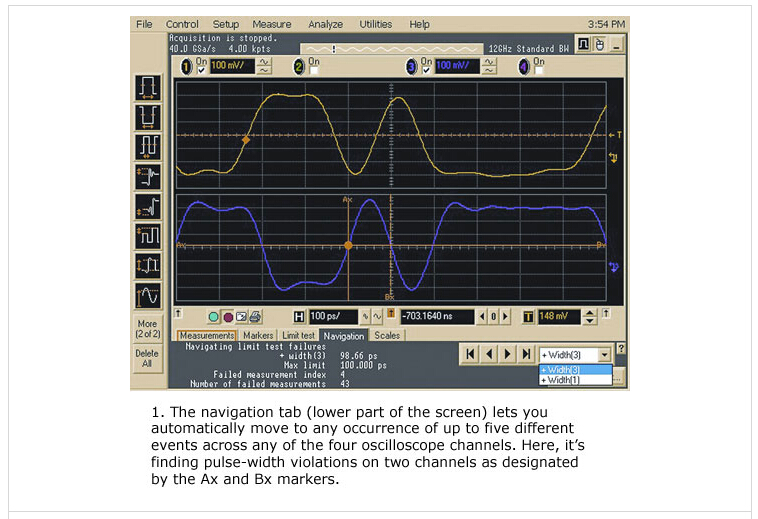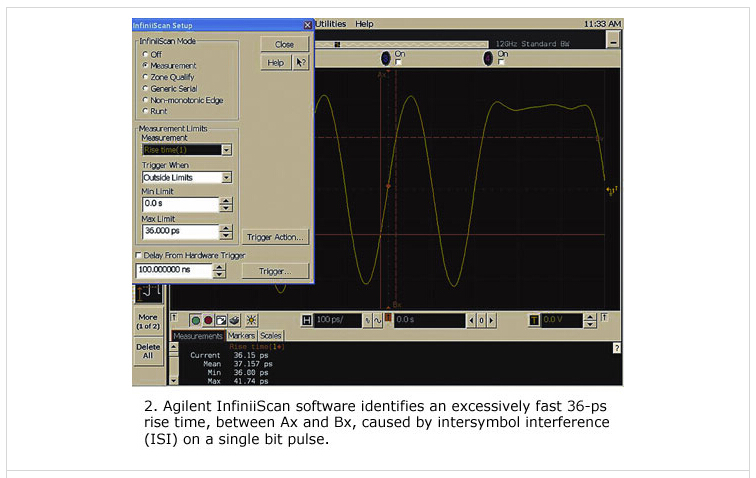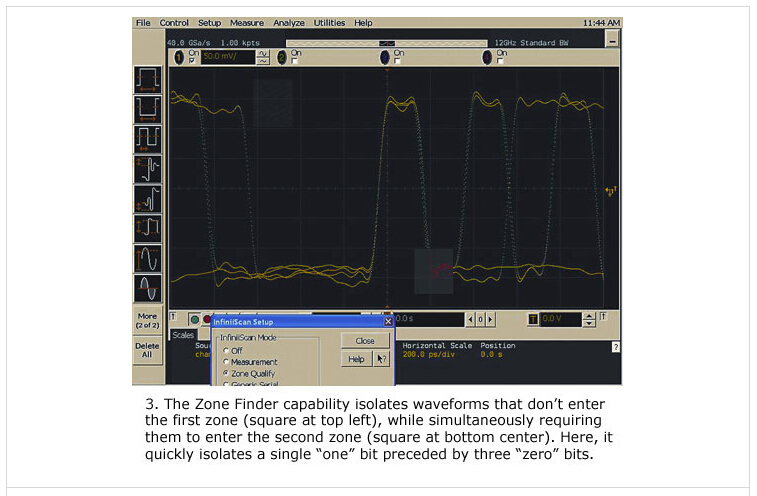
Support Team
Feedback:
support@nextpcb.comWith the emergence of a new kind of event location technology, this situation will be greatly improved. Ultimately, this powerful event location system will effectively help design engineers quickly and easily identify signal integrity issues.
Traditional signal integrity problem location method
Traditional hardware trigger/depth acquisition storage methods have two major advantages in locating signal integrity issues.
First, there is no dead time when locking a related event with a hardware trigger. The hardware trigger system keeps the oscilloscope acquisition system running until the target event is found. Once the target event is locked, the hardware trigger circuit will trigger to complete the oscilloscope's data acquisition while displaying this event in the center of the screen. This method is really very convenient.
Secondly, with deep acquisition and storage technology, users do not need to know the type of signal integrity problem faced by the target system. Simply set the oscilloscope to the maximum storage mode, set the trigger mode to edge trigger, or even automatically trigger, then let the oscilloscope Start running. The oscilloscope will capture a relatively long screenshot of the target system's performance, and the user can analyze the data at any time to determine if there is a problematic event. This technology is also known as the "swallow and wallow" technology.
These methods of validating designs with oscilloscopes are very effective and have been well received in the electronic design engineer community. But there are still many limitations to this approach compared to emerging technologies in the test/measure industry.
New method for locating signal integrity problems
A new approach to locating signal integrity issues is an event recognition software. Event recognition software is essentially an intelligent software that scans waveforms captured by an oscilloscope to find various signal integrity problems or signal-related events. This method does not have the "no dead time" feature of the hardware trigger method. This is because there is a "dead time" when post-processing the previously captured data, and it does not have the "wide range" that deep acquisition storage technology can provide. The ability to save and check. But event recognition software has some unique advantages that are attracting more and more oscilloscope users.
1. Simultaneous monitoring of multiple events: The hardware triggering method can only identify a problematic event, and the hardware triggering circuit is set to trigger when a specific event occurs, which fundamentally eliminates the possibility of simultaneously monitoring multiple events. While the event recognition software is not affected by this limitation, the software can be programmed to simultaneously scan 5 events on any channel or channels. This greatly reduces the time it takes to gradually reduce the potential causes of signal integrity problems and the time it takes to isolate complex and complex related events.
2. Find out how many times the same event occurs: the hardware trigger circuit can only recognize a single occurrence of an event per capture. In fact, the event will appear multiple times before or after this event is isolated by hardware, but the hardware trigger method cannot find these recurring events. Event recognition software can do this by finding out all the occurrences of events captured by the waveform memory. Therefore, the design engineer can not only find the first failure, but also the second and third failures.
3. Event Navigation: Once a user captures a long waveform through deep storage, the next step is extremely tedious and error-prone manual work, playing back the waveforms, examining each segment of the waveform, and identifying potential signal integrity issues. Deep acquisition storage technology can capture information on 10,000 screens. It is impractical to manually review all of this information. It is unrealistic and time consuming to transfer these oscilloscope data to a controller and write custom software to analyze the data. Once the event recognition software recognizes all occurrences of the target event, it can switch back and forth between multiple occurrences of this event using the same intuitive playback control button as the DVD player. Figure 1 shows a test example using an Agilent DSO81304B oscilloscope.

4. Identify multiple events: A typical hardware trigger system can isolate approximately 10 different types of events or trigger patterns. But developing a new hardware trigger mode is very cumbersome for oscilloscope vendors, requiring a lot of development resources and expensive IC production costs. In contrast, the cost of developing event recognition software is much less. Current event recognition software isolates any event that can be measured by waveform measurements (modern oscilloscopes can perform more than 30 waveform measurements), as well as problematic events such as non-monotonic edges caused by incorrect signal terminals. It is almost impossible to trigger small waveforms such as non-monotonic edges with hardware trigger circuits.
5. Speed of discerning events: The speed of the hardware trigger circuit is primarily affected by the speed of its transistors, and it uses analog techniques. Now the highest-end hardware trigger circuit can achieve pulse width (or pulse interference) triggers as low as 300ps, and 3.25Gbps serial triggering. Although these indicators are excellent, the speed of the hardware trigger circuit still can't keep up with the speed of 8.5Gbps or higher of today's top systems. Event recognition software is limited only by the oscilloscope's sampling rate, which is essentially digital. Industry-leading oscilloscopes have sample rates up to 40 GSps, and event recognition systems are faster than hardware triggers by software event recognition systems. The new technology can observe events with a pulse width of 70 ps and its sequence search speed can reach 8.5 Gbps (see another high-speed signal test example shown in Figure 2).

6. Discriminating the resolution of the event: The time resolution of the hardware trigger circuit is relatively low. The resolution is about tens or even hundreds of picoseconds depending on the trigger event, the waveform signal characteristics, and the specific waveform activity that causes the trigger event. When it is necessary to measure some more accurate indicators, this resolution is no longer sufficient (that is, a false fault may occur). Since software events recognize pure digital signal processing, DSP techniques such as 1 to 16 sample point interpolation algorithms can be used to effectively increase event resolution. The inspection of the event pass rate can be increased to the picosecond level. Figure 2 shows the waveform of the oscilloscope identifying the rising edge of 36ps.

7. Visible to isolate: The most attractive aspect of event recognition software is its Zone Finder feature. Many oscilloscope users will see occasional intermittent flashes on the screen, but they won't have time to press the stop button to lock them. Usually in this case, the user will set the oscilloscope to single acquisition mode, and then press the single trigger button (sometimes need to press very many times) to effectively capture an event. In most cases, the result will only make your fingers sore. The area detector allows the user to draw an area on the screen. The user can observe the intermittent signal flashing in this area. When the waveform of this signal flashes this area next time, the oscilloscope will automatically stop and display the waveform clearly. . Figure 3 shows an example with two regions. This feature is usually very useful.
8. Synchronization with hardware triggers: Event recognition software can be used with hardware triggering mechanisms through a programmable delay mechanism. That is, this method captures software-defined events that occur when a specified time is delayed after a defined hardware event. This combination of hardware and software can generate a trigger sequencer, or it can use hardware to limit the waveforms that the software checks to improve efficiency.
Event recognition software is an effective complement to traditional hardware triggering or deep acquisition storage methods for identifying signal integrity issues. When the oscilloscope does not have a "dead time" problem, that is, the event occurs more frequently than once per second (one second is a long time for high-speed circuits), the new technology of event recognition software will become the target. One of the most effective and flexible tools for signal integrity issues in electronic design.
Still, need help? Contact Us: support@nextpcb.com
Need a PCB or PCBA quote? Quote now
|
Dimensions: (mm) |
|
|
Quantity: (pcs) |
|
|
Layers: |
Thickness: |
|
|
|